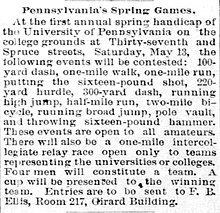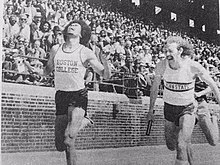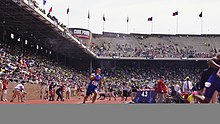Penn Relays
The Penn Relays (officially The Penn Relay Carnival) is the oldest and largest track and field competition in the United States, hosted annually since April 21, 1895 by the University of Pennsylvania at Franklin Field in Philadelphia.
More athletes run in the Penn Relays than at any other track and field meet in the world.
[1] It regularly attracts more than 15,000 participants from high schools, colleges, and track clubs throughout North America and abroad, notably Jamaica, competing in more than 300 events over five days.
The Princeton men won with a time of 3:34, beating the University of Pennsylvania (Penn) by 8 yards.
In 1894, Penn hosted the track and field meet at the university athletic grounds at 37th and Spruce Streets on April 21, 1894.
[1] The first Penn Relay Carnival, held on April 21, 1895, at Franklin Field, was a success.
In the two years after that, the following events were added to the meet: 100-yard dash, 220-yard dash, 120-yard hurdles, high jump, pole vault, long jump, shot put and hammer throw.
[1] Also in 1910, the Intercollegiate Association of Amateur Athletes of America created The Relay Racing Code.
The Code created a 20-foot area in front of the starting line in which a touch-off between legs or runners of the relay could be made.
This rule later became the rule for the exchange zone or the 20-meter zone (10 meters in front of the finish line, 10 meters behind the finish line) in which a baton can be passed from one leg of a relay to another.
In 1914, Oxford University turned the Penn Relay Carnival into an international event, becoming the first team outside of the United States to compete.
Around that same time, the loudspeaker was added to the stadium which helped inform the spectators of the events on the track.
[1] In an effort to gain more participants in the relays, six new lanes were added to the inside of the track.
That same year the northwest corner of the stadium, previously used as the finishing chute, was now used for the paddock area, where athletes were lined up and organized before their race.
Two years later the high school girls 440-yard relays was added to the carnival.
That same year Jamaican high schools started to compete in the meet.
Then in 1976, the events were converted into meters instead of yards except for the mile and the 4x120-yard shuttle hurdle relay.
In 1988, the carnival used corporate sponsorship instead of just earning money from tickets sold at the door like it had in the years before.
In the years that followed, the crowd and number of participants gradually increased and the carnival would become nationally and internationally more popular.
The World" program, pitting American teams against elite runners including Usain Bolt, Shelly-Ann Fraser and Alfred Kirwa Yego.
The event broke all previous attendance records with a single-day high of 54,310 and the total of 117,346 for the three-day festival.
[3] At the 2016 Relays, Ida Keeling became the first woman in history to complete a 100-meter run at the age of 100, which she did with a time of 1:17.33.
[7] In 2021, organisers split the Penn Relays into two different events -- the Philadelphia Metropolitan Collegiate Invitational presented by Toyota for colleges on the traditional weekend,[8] and the Summer Series, which featured open races held in mid-July.
Franklin Field was opened in 1895 specifically for the first Penn Relay Carnival.
The picture on the awards features the founder of the University of Pennsylvania, Benjamin Franklin, sitting in his library chair holding a laurel sprig in his left hand.
Former University of Pennsylvania runners Larry Brown, Louis Madeira, George Orton and Ted Meredith posed as models for the design.
[1] The winning team in the college "Championship of America" relays will receive an 18" bronze plaque.
The prizes for the college relays are the same for the Military Academies races except the individuals on the first place teams will receive gold watches as well and the plaque.
[12] The winning team in the high school "Championship of America" relays will receive an 18" bronze plaque.
Just like in the high school championship relays, the first American individual will receive the gold watch.




